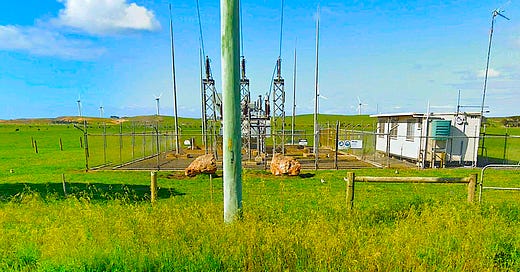You Can Pretend to Repower the Wind But It Isn't Happening Because There's No Money In It for the Grifters
JoNova has yet another superb post out today. It focuses on yet another green fantasy: that old wind farms can simply be repowered to produce the energy we were all told would be just stupendous when first built. You know, “enough to power a zillion homes” or “the equivalent of taking two zillion combustion engines off the road.” It turns out the repowering fantasy is even bigger than first.
Take for example, this story from Wind Europe (emphasis added):
Across Europe more and more wind turbines start to reach the end of their operational lifetime. Repowering them – replacing them with new turbines – is proving to be very effective. You get more than three times as much power from the same site. But not enough repowering is happening yet…
WindEurope’s “End of Life Issues and Strategies” seminar (EoLIS 2024) started today in Gothenburg. The event showcases the latest trends in repowering, decommissioning and recycling of wind turbines.
More and more wind turbines are approaching the end of their operational lifetime and technology is rapidly advancing. But repowering – replacing older wind turbines with newer, more efficient models – is only slowly gaining traction across Europe.
“More electricity with fewer turbines – repowering is a no-brainer. But Governments are not doing enough to drive it. Most old wind farms just carry on with inefficient turbines”, said Giles Dickson, WindEurope CEO.
Data analysed by WindEurope shows that nowadays repowering on average reduces the number of turbines in a wind farm by 25%, while more than tripling the output of the wind farm and quadrupling the output per wind turbine.
Reasons for the improved efficiency of modern turbines include longer rotor blades which increase the overall swept area of the turbine, higher capacity factors, improved aerodynamics through improvements in blade design, more stable electricity generation in times of low wind speeds as well as advanced control systems which optimise the real-time operation of the turbines.
“The European Commission has put forward key permitting and repowering provisions in the revised Renewable Energy Directive. They now need to be implemented. We believe repowering should be a big contributor to achieving our energy and climate targets. Accelerating implementation efforts is a key priority for the new Commission. We will support the Member States here”, said Paula Rey Garcia, Deputy Head of Unit for Renewables and Energy System Integration Policy at the European Commission’s Directorate General for Energy.
Let's interpret:
The orginal wind turbines we told you would save the planet and power everything were inefficient pieces of subsidized crap that need to be replaced.
You need to replace them with much bigger pieces of crap and you need to do it now. We'll give you the money by raising the rates on your consumers.
We’ve given you our instructions. Now, get to it immediately and tolerate no more resistance from our grifters. We must maintain the fantasy on which our power and their grift depends.
And, the reasons for the resistance? Well, that story comes from Renew Economy and is from Australia:
In a first clue as to what might be the future for some ageing wind farms sites, renewable energy company Pacific Blue says it will not repower the country’s oldest commercial wind farm at Codrington in Victoria.
The 18.2 megawatt (MW) Codrington wind farm was commissioned in 2001 and will be decommissioned in 2027, a Pacific Blue spokesperson told Renew Economy on Monday.
Despite an enviable location near Port Fairy in southwest Victoria, which benefited from the same southern ocean winds that drew the federal government to the offshore Southern Wind zone, repowering the site will be too expensive, the company says.
“At this stage, Pacific Blue is not pursuing a repowering option for Codrington, as the site’s grid connection would require significant upgrades and today’s turbine siting requirements would preclude the installation of latest generation turbines, resulting in a non-financially viable project,” the spokesperson said.
Repowering a wind farm has become common in some countries, but it is more than just a cosmetic makeover, with Codrington a case in point: its 1990s design turbines are only rated at 1.3 megawatt (MW) each, with a hub height of 50m and blade tip height of 81m.
Today’s modern turbines are rated at between 6 MW and 8MW of capacity, with tip heights above 200m. And they are only likely to get bigger.
The size difference alone means new foundations, new sites as the turbines need to be spaced differently, and upgraded infrastructure to send any extra power into the grid.
All of that requires the proponent to go through all of the regulatory approvals processes anew and secure a new connection agreement.
Pacific Blue – formerly known as Pacific Hydro, but which changed its name in 2023 after a buyout by China’s State Power Investment Corporation (SPIC) – has started early talks with the Moyne Shire council, state authorities and regulators about its decommissioning plans, and says it met with landowners in 2024.
Let's interpret once more:
The original wind farm was nothing more than a wasteful Federal demonstration project in which the grifters were only too happy to participate.
The promises made of a future free and clean electricity source were all lies.
Communist China doesn’t give a damn about your virtue signaling or your energy security and isn’t going waste its money on either.
It’s all just one more sign net zero is zeroing out.
#Climate #NetZero #Wind #Europe #Australia #Europe #Grifters #China #Codrington





